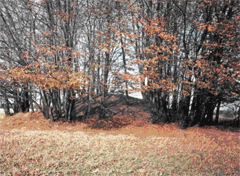Pidgirtsy is a village and the center of village soviet. It is located over the highway from Zolochiv to  Brody, in 1,7 km from a route from Kyiv to Lviv on the slopes of mountains of Voronyaky, which rise here to 403 m above a sea level. Distance to the district center of Brody is 24 km. A population of Pidgirtsy is approximately 1400 persons.
Brody, in 1,7 km from a route from Kyiv to Lviv on the slopes of mountains of Voronyaky, which rise here to 403 m above a sea level. Distance to the district center of Brody is 24 km. A population of Pidgirtsy is approximately 1400 persons.
Fences surrounding village since old times attracted people. Already in VII-XIV centuries here, on an advantageous for a defensive place on one of mountains there was the oldа settlement of Plisnesk. It is mentioned under the differentа names in chronicles after 1188 and 1233 years. The first annalistic mention is related with the unsuccessful attempt of prince Roman Galitskiy to drive out Galichina boyars and their allies - Hungarian feudal lords from Plisnesk. Secondа reports are connected with the victory in Plisnesk of Daniel Romanovich above boyars of Arbuzovichy. The аsite of ancient settlement, which was saved, now is named gorodische. It has an area about 160 hectares аand is surrounded with the system of earthen banks and ditches in general length of approximately 7 km. It is the best sight of old buildings and fortifications. Gorodische is divided in two parts: a strong, fixed overhead part with externalа and internal banks( it is located on a high plateau), and the lower part on the slopes of the banks. There were wooden walls (so-called zaboroly) and towers of defensives on the banks. The external slopes of separate banks were paved with stone flags.
аThe territory of ancient cemetery, where the several hundreds of burial mounds of X-XIа centuries were saved, adjoins the north part of gorodische.
From a western side gorodische abuts upon a place, where a monastery has been founded allegedly about 1180 year by Helen ( she was a daughter of prince Vsevolod Belz'kiy). In 1706 year old monasterial houses were taken apart and stone apartments were built from the south-west side of gorodische.
The first archaeological excavations had been taken in Plisnesk in 1810, the wide planned researches were conducted in 1946 - 1954 years. Over 70 houses and economical buildings, tailings of the city, burial places of ordinary habitants and princely retinue of X-XI centuries were found. A large material was collected during the excavations. This material illustrates gradual development of Plisnesk from the settlement of rural type to the feudal city which was one of the most developementа Old Russian handicraft and trading city. The consequences of archaeological study of Plisnesk enable to select in his history 4 periods which are dated by VII - VIII,а IX - X,а XI and by XII - XIII centuries.
In the first period the territory of this unfortifiedа settlement of East Slavonic tribesа did not exceed 10 Ц 12 hectares. Some information testifies that at that time the process of the second public division of labour was completed already in Plisnesk аand there were separate industries of handicraft (treatment of iron, pottery).а The second period is characterized with the mode in which a small individual family was the basic production unit. The feudal apex of a few settlements of rural type was engendered, that existed in a place of future city and occupied the area of about 150 hectares.The third period of the history of Plisnesk is reflected in further development of feudal relations. Territory of the settlement diminished to the relatively small fixed part, where feudal gentlefolks lived with a well-armed retinue.
Some artisans appeared at the court of feudal lord. Christian religion spread among the population of Plisnesk. During a fourth period Plisnesk becomes one of the largest cities of Galichina. The difficult system of buildings of defensives of the city is complete at this time; a handicraft (blacksmith's, pottery, woodworking, jewellery and others like that) becomes the basis of the economic activity of citizens of the town. Plisnesk which is located on the crossing of trade routes, grows into the large center of handicraft and trading of ancient Russia. Subsequent development of the city was interrupted with Tatar and Mongolian аinvasion. In 1241а Plisnesk, as well as the most Old Russian cities, was blasted with the troops of Batiy. In the second part of XIII and in XIV centuries a small part of gorodische was yet populated, but basic territory of former city was unpopulated ( it was partly regenerate in a cemetery). The documents of the middle of XV century do not mention Plisnesk at all.а